
On the North-East coast of England, the holy island of Lindisfarne lies a little offshore from the ancient royal settlement of Bamburgh. The later castle of Bamburgh is on the site of the ancient British fortress of Din Guardi, the fortress of the Kings of Bernicia, the Northern region to the East of the Pennines. The pagan Angles gained control of this region in the middle of the 6th century.
There was continuing warfare and conflict and the kingdom was often divided. In AD 604, St Oswald, the godly king, was born into the royal family of Bernicia but he was forced into exile as a youth and went to the monastery on the islands of Iona in the West of Scotland, founded by St Columba where he was baptised into the Christian faith. He returned to claim the throne in AD 635 and sent word to Iona asking that a bishop be consecrated to evangelise the people and establish the Church. St Aidan travelled to Bamburgh and was given the island of Lindisfarne to be his episcopal seat.

St Aidan began to evangelise the people of the royal settlement at Bamburgh and because he was not fluent in the Old English language the King would accompany him and translate his teaching and preaching. Many other monks followed St Aidan and assisted him in preaching, baptising and celebrating the services of the Church.
It was the practice of St Aidan to live out the Christian life as he preached it. Therefore he gave away everything to the poor that he received as gifts from the King and other noblemen. He always went among the small villages and remote arms on foot, and he greeted those who were not believers, seeking to teach them the Christian hope, and he encouraged those who were already baptised, to stir them up to good works.
He practised unceasing meditation on the Scriptures and spent time learning and praying the Psalms. He fasted every Wednesday and Friday until the 9th hour except during the season of Pentecost. He never gave gifts of money to the powerful, and when he ate with the King would take only a small meal and leave. If he was given any money he used it for the poor or ransomed those who had been made slaves.

On one occasion, King Oswald was about to eat, and a silver dish of the best of food had been brought to him. At that moment the servant who had the care of the poor came to him and informed him that there was those who were in need waiting outside. He took the precious dish and commanded that the food be shared with those who had none and that the silver be cut up and distributed to the poor. St Aidan was sitting beside him, whose example King Oswald was following, and he laid his hand on his arm and blessed him saying, “May this hand never perish!”
Some of the miracles of St Aidan are recorded.
On one occasion, a priest called Utta, respected by all, was sent to the Kingdom of Kent to bring back Princess Eanfleda who had been exiled when her father had been killed. St Aidan gave a flask of holy oil to the priest Utta, saying to him, “I know that when you go abroad, you will meet with a storm and contrary wind; but do you remember to cast this oil I give you into the sea, and the wind shall cease immediately; you will have pleasant calm weather, and return home safe.” This was exactly what happened, and was recounted by someone who had heard it directly from Utta himself.
On another occasion, the pagan King Penda of the Mercians besieged the royal fortress at Bamburgh after destroying many villages. He arranged for a great mound of wood and thatch to be piled against the walls of the town. When this pyre was lit a great cloud of black smoke arose. St Aidan was on retreat on the Farne Islands just a few miles from Bamburgh, and seeing the smoke he cried out in prayer, “Behold, Lord, how great mischief Penda does!”, and by his prayers, the wind changed direction and blew the flames and smoke against Penda and his men, they retreated in fear and chaos understanding that God protected that place.
After St Aidan had been bishop for sixteen years he passed away in AD 651. He was in prayer at the wooden church he had built outside the fortress of Bamburgh, where a later stone church now stands. He was reclining against one of the wooden pillars that supported the church when he gave up his spirit. His body was taken to the monastery on Lindisfarne, and when a larger church was built on Lindisfarne his remains were placed beside the altar in great honour. He died on the last day of August. Penda of the Mercians returned to wage war and the wooden church was burned, but the wooden post against which St Aidan had rested when he passed away alone survived. The church was rebuilt in wood, but later there was a fire that destroyed it again, but even though the wooden panels around it were consumed, this sacred post was preserved.

When the church was built again this post was placed inside the church and became a place of pilgrimage and many were healed. In the church which stands there now, constructed of stone in the 12th century, this holy wooden pillar can be seen in the roof timbers and is not part of the roof but stands out as something unique.
The Viking attacks on monasteries in the North-East led to the remains of St Aidan being translated to Iona, and Durham, and some found their way to Glastonbury. But he was buried first on Lindisfarne, and perhaps some of his remains are there still.
We can visit the sites associated with St Aidan at Iona, where he became a monk, and then at Bamburgh and the church where he died, on Lindisfarne where he built his monastery and was buried, and in Durham where some of his remains were taken.
May the prayers of St Aidan, the Apostle of Northumbria, be with us all.
